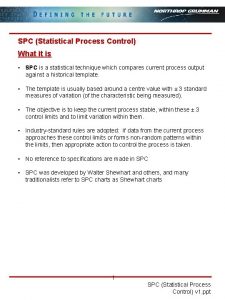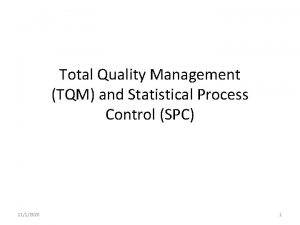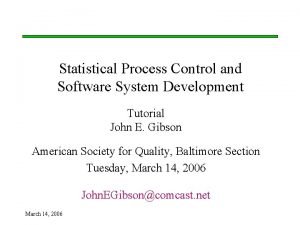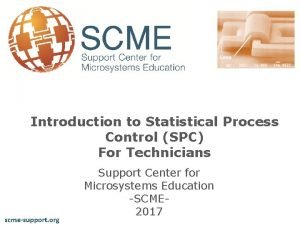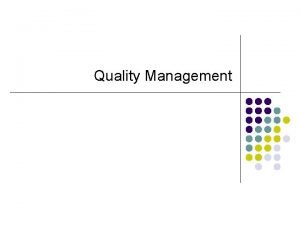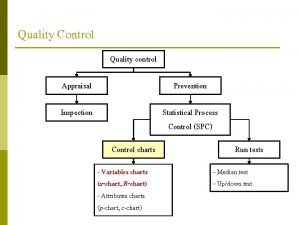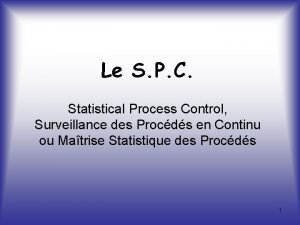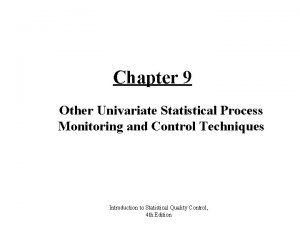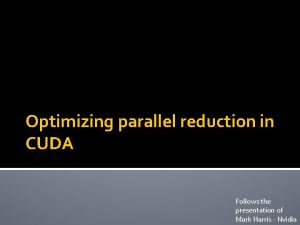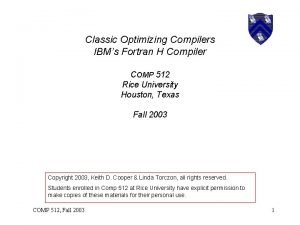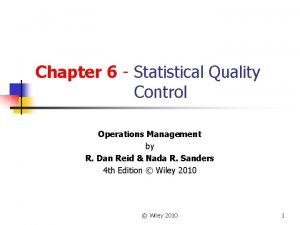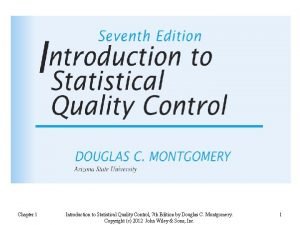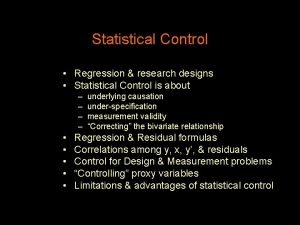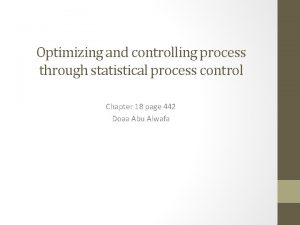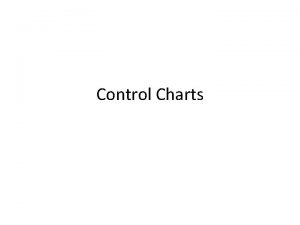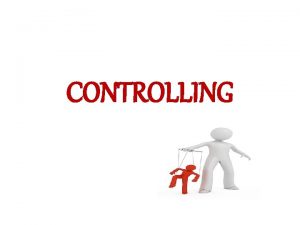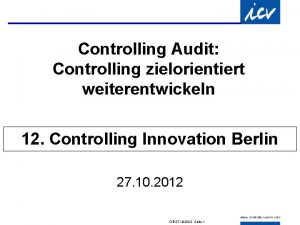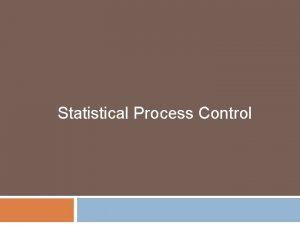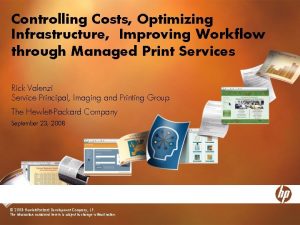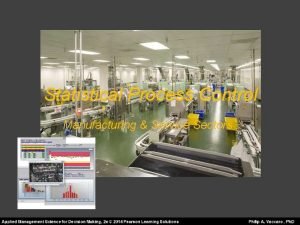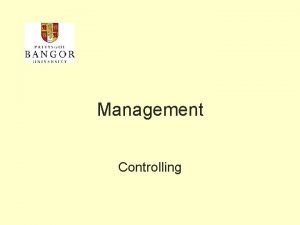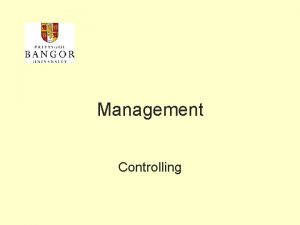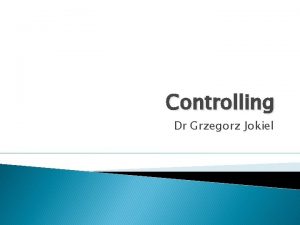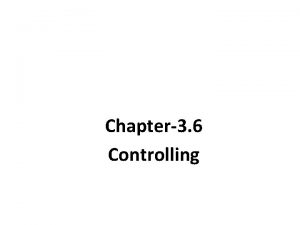Optimizing and controlling process through statistical process control

















- Slides: 17

Optimizing and controlling process through statistical process control page 442

Chapter Outline • Major topics: 1. Statistical Process Control Defined 2. 3. 4. 5. 6. 7. Rationale for SPC Control chart development Management’s role in SPC Role of the total quality tools Implementation and deployment of SPC Inhibitors of SPC

STATISTICAL PROCESS CONTROL DEFINED • All process are affected by multiple factors such as: 1. The environment the machines employed 2. The materials used 3. The methods(work instruction) provides 4. The measurement taken 5. The manpower(people) who operate the process • These factors are called the 5 M’s

STASTISTICAL PROCESS CONTROL DEFINED • Statistical process control (SPC) is a statistical method of separating variation resulting from special causes from variation resulting from natural causes in order to eliminate the special causes and to establish and maintain consistency in the process, enabling process improvement.

Rationale for SPC 1. Control of variation 2. Continual improvement 3. Predictability of processes 4. Elimination of waste 5. Product inspection See page no. 444

Control chart development Data category Chart type Statistical quality application Variables(measured values) x bar-R( See figure page 453 Mean value and range Charts dimensions and their precision, weight, time, strength, and other measurable quantities. example: anything physically measurable x tilde-R( Median and range Charts measurable quantities, similar to x bar-R, but requires fewer calculation to plot. Example as above

Control chart development(continue) Data category Chart type Statistical quality application Variables(measured values) x-Rs(also called xchart See figure page 453 Individual measured values Used with long sample intervals; when subgrouping not possible. Example: products made in batches such as solution, coaching, etc. or grouping too expensive. Histogram must be normal

Control chart development(continue) Data category Chart type Statistical quality application Attributes(counted values) p-chart See figures page 454, 455 Percentage defective Charts the number (also fraction of defects in samples defective) of varying size as a percentage or fraction. Example: anywhere defects can be counted np-chart(also pn) Number of defective Charts the number pieces of defective pieces in sample of fixed size. Example: as above, but in fixed-size samples

Control chart development(continue) Data category Chart type Statistical quality application Attributes(counted values) c-chart See figure page 457 Number of defects Charts the number of defects in a product( single piece) of fixed size. Example: specific assemblies or products( e. g. , pc boards, tires) u-chart Number of defects per Charts the unit area, time, length, number of etc. defects in a product of varying size (i. e. , unlike products). Example: Carpet( area), extrusions length)

Management’s role in SPC 1. Commitment 2. Training 3. Involvement See page 462

Role of the total quality tools • There are several tools: 1. Pareto charts 2. Cause and effect diagrams 3. Stratification 4. Check sheets 5. Histograms 6. Scatter diagrams 7. Run charts and control charts 8. Flow charts 9. Design of experiments 10. Five-s 11. Failure mode and effects analysis(FMEA)

Role of the total quality tools(continue) • With SPC, the total quality tools have a dual role: • First: they help eliminate special causes from the process so that the process can be brought under control. • Second: their second role comes into play when, from time to time, the control chart reveals cause or when the operators wants to improve a process that is in control. • See page 463

Implementation and deployment of SPC • The implementation steps are divided into three phases: 1. Preparation 2. Planning 3. Execution See page 465 for detailed study

Implementation and deployment of SPC (continue) phase preparation responsibility Top management Consultant or in-house expert planning SPC committee assisted by consultant or experts Consultant or in-house expert QA Management action Step 1: Commit to SPC Step 2: Organize SPC committee Step 3: Train SPC committee Step 4: Set SPC objectives Step 5: Identify target processes Step 6: train appropriate operators and support personnel Step 7: ensure repeatability of instruments and methods Step 8: delegate responsibility for operators to play key role

Implementation and deployment of SPC (continue) phase execution responsibility action SPC committee, operators, suppliers, customers Operator w/ expert assistance Consultant or in-house expert Operator Step 9: flowchart the process Step 10: eliminate the special causes of variation Step 11: develop control charts Step 12: collect and plot SPC data; monitor Step 13: determine process capability Step 14: Respond to trends and out-of-limits data Step 15: track SPC data Operator w/ expert assistance Operator SPC committee and management Operator w/ assistance as required All Step 16: eliminate root causes of any new special causes of variation Step 17: continually improve the process (narrow the limits)

Inhibitors of SPC 1. Capability in statistics 2. Misdirected responsibility for SPC 3. Failure to understand the target process 4. Failure to have processes under control 5. Inadequate training and discipline 6. Measurement repeatability and reproducibility 7. low production rates • See page 471 -473 • Discussion Assignment 18 -2 on page no. 479 “ The start of the Japanese Quality Movement”

External Links • Watch the Youtube link and go through the research to understand the topic better. • https: //www. youtube. com/watch? v=0 Gf. BSuwh. Uw. I • https: //www. sciencedirect. com/science/article/pii/S 2212827 116001529
 Statistical process control ppt
Statistical process control ppt Statistical process control in total quality management
Statistical process control in total quality management Statistical process control tutorial
Statistical process control tutorial Control chart variation
Control chart variation Statistical process control
Statistical process control Project control chart
Project control chart Statistical process control definition
Statistical process control definition Statistical process control
Statistical process control How is economizing different from optimizing?
How is economizing different from optimizing? Cuda parallel reduction
Cuda parallel reduction Optimizing parallel reduction in cuda
Optimizing parallel reduction in cuda The fortran optimizing compiler
The fortran optimizing compiler Dr moza
Dr moza Tangent-sawing
Tangent-sawing Product vs process
Product vs process Statistical quality control in operations management
Statistical quality control in operations management Introduction to statistical quality control
Introduction to statistical quality control Statistical control in research
Statistical control in research
